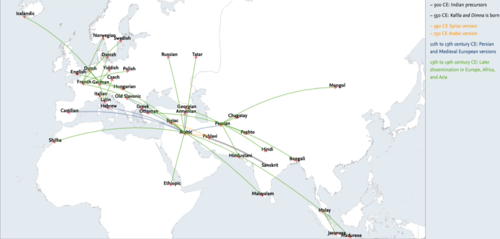World Literature
kd_dissemination
Image Credit: Kalila and Dimna — AnonymClassic, Freie Universität Berlin, Advanced Grant funded by the European Research Council (ERC)
Prof. Dr. Beatrice Gründler
Kalīla and Dimna, the work at the center of the project’s research, is a cosmopolitan work of wisdom literature. More precisely, it is a mirror of princes in the form of animal fables that was avidly read, copied, translated and rewritten in an area stretching from Spain to Malaysia in more than 40 languages until the 19th century. From its Sanskrit origins, it traveled to Europe and Asia, via an intermediate Arabic phase, and it became the most widely spread European medieval text. The archaeologist James Henry Breasted, the founder of the Chicago Oriental Institute, once described it as, “an ancient text which, next to the Bible, has become the most widely distributed and translated book in the entire history of literature,” and he made it one of the pilot projects of his Institute, created in 1919 with the support of John D. Rockefeller as “a laboratory for the study of the rise and development of civilization.”
Retracing the chronology of Kalīla and Dimna requires delving into deep time: its earliest Sanskrit sources, the Pañcatantra and the Mahābhārata, took their final shape approximately in the third and fourth century CE respectively. A selection from these was translated and redacted in Middle Persian in the sixth century. A Syriac version produced a few decades later received no further translations. In the eighth century, however, this version was then translated into Arabic and expanded, and from there it branched out in the 11th to 13th centuries into multiple European and Near Eastern translations. The European “bridge” version was the Latin translation (via Hebrew), which generated all modern European translations, including outliers such as Danish, Hungarian and Czech. The vernacular language Kalīla and Dimna is first and most often translated into is German, beginning in 1482. But French, with slightly fewer translations, is the language the work was subsequently most translated out of. The Persian versions, especially the Anvar-i Sohaili (15th century) and the Ottoman Humayun Nameh (16th century) became classics in their own right. The work then received a renewed reception in the 19th century in South and Southeast Asia, where it resurfaced in eight languages, from Hindi and Bengali to Madurese to Malay. It moreover gave rise to versifications and emulations in many of these languages.
Yet despite its renown, Kalīla and Dimna still holds mysteries. Research came to a grinding halt in the early decades of the last century, when scholars no longer had mastery of the many languages needed to appreciate its global dissemination. At the same time, the book is found on the shelves of modern Arabic bookshops in the children’s section—although the text given in these varies widely from one copy to another. One can say that Kalīla wa-Dimna is an unstable text, resembling an impressionist painting, clearly recognizable from afar, but perplexing and confusing when one looks close up. The AnonymClassic project seeks to understand this text both in the Arabic context, where it spurred numerous adaptions and emulations and in its multifarious interaction with global literature, which is still ongoing today.
